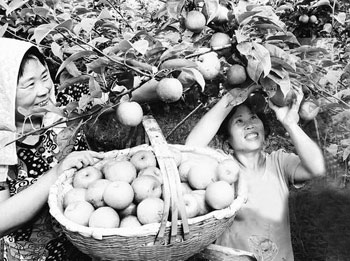Pear industry technology system helps to turn life upside down
Original title: "pear blossoms" prompted by the spring breeze

Pick pears. Photo Source: Baidu Pictures
The cultivation of pear has a very long history, which has been recorded for more than 3000 years. It is a fruit with special characteristics and cultural heritage.
As the largest pear producing country in the world, China has a total pear area of 1.11 million hectares and a total output of 17.3 million tons, accounting for 62.9% of the total area of pears in the world and 68.6% of the total yield.
"the pear industry in China is characterized by wide distribution, many domestic varieties, huge output, low price and so on." Professor Zhang Shaoling, chief scientist of modern agricultural (pear) industrial technology system and director of the Pear Engineering Technology Research Center of Nanjing Agricultural University, said in an interview with China Science Daily that with the establishment of the national pear industrial technology system, the pear industry has undergone earth-shaking changes.
Low export prices due to extensive industry
Pear is the third largest fruit tree in China, and its area and yield are second only to apples and oranges. However, the planting area and yield of pears in China rank first in the world. China is the country that produces the most pears in the world. For example, seven out of every 10 pears produced in the world are produced in China.
Pears are widely distributed in China and are cultivated from south to north except Hainan Province.
"Pear has a very important feature, that is, about 85% of the pear varieties cultivated in China are our own traditional local varieties, or self-cultivated varieties, and the proportion of domestic varieties is getting higher and higher." Zhang Shaoling said, "this is a major advantage in China's pear industry at present."
In recent years, China's annual pear export volume is about 400000 tons, ranking first in the world. The main exporting countries are Malaysia, Indonesia and other Southeast Asian countries and neighboring countries such as Russia, while some developed countries also have a small amount of exports.
"however, the price of pears exported by China is not high, which is lower than the average price in the world." Zhang Shaoling said that this is because the quality of the pear is slightly worse, the cultivation of the pear is relatively extensive, the overall production level is relatively low, and the competitiveness to enter the international market is poor.
Pear has a wide range of adaptability and variety, showing the characteristics of "three regions and four points". The "three areas" are Baili District in North China, Baili District in Northwest China, and Shali District in the middle and lower reaches of the Yangtze River. "four points" refers to the characteristic pear area, including Liaoning Nanguo pear, Yunnan Hongpi pear, Korla fragrant pear and Jiaodong Xiyang pear.
Scientific and technological progress is outstanding
In the face of the complex domestic pear industry, after several years of system implementation, "the whole scientific and technological progress is still relatively great." Zhang Shaoling concluded.
First of all, the pear industry has basically achieved steady and rapid development in recent years. Overall, the area of pears has increased by nearly 1 million mu, and the output has increased by about 2 million tons. The total output has increased and increased steadily. The per unit yield is higher than in the past, and the number of high-quality fruits and good fruits has increased a lot.
Through the construction and operation of the pear industrial technology system, it has promoted the popularization and application of new pear varieties and new technologies in 105 demonstration counties (districts) of 19 provinces (municipalities and autonomous regions), and established 207high-level standard demonstration gardens with an area of about 66000 mu and a radiation extension area of more than 5 million mu.
Especially in the aspect of light simplification of production technology, the reform of labor-saving, efficient and light simplified and efficient cultivation mode has played a great leading role in promoting the development of labor-saving and efficient cultivation mode. This is very suitable for the development trend of modern orchards.
Compared with the traditional pollination operation, the pollination efficiency of the liquid pollination technology developed by Zhang Shaoling's research group can be increased by 36 times. "for example, it takes 1.5 people a day to pollinate an acre of pear orchards, while with liquid pollination, one person can do the same amount of work in an hour. Especially in the flowering period of less than a week, it can save labor and improve efficiency. " Zhang Shaoling said.
In recent years, Dongzigi Agricultural Ecological Park, which has a long-term technical cooperation with Nanjing Agricultural University, has also enjoyed the great benefits brought by science and technology.
"Nanjing Agricultural University is the technical support of our pear orchard." Ren Bomin, head of Dongzhitianmu Agricultural Ecological Park, lamented in an interview with China Science Daily that cooperation with universities has solved the technical worries for enterprises.
According to him, the help and support in cultivation management, variety improvement, and other techniques have enabled the orchard to produce high-quality pear fruit. "in general, the yield of 3000 jin per mu of pear orchard is very good. We can basically achieve a yield of about 4500 jin per mu. Not only the output is higher, the quality is also better, the market price is also more considerable. "
There is also a technology that makes Zhang Shaoling feel very meaningful, "that is, we have solved the industrial problem of the high proportion of 'male pears' (perennial calyx fruits) of pear varieties such as Korla fragrant pear."
On the market, the price of "female pear" (de-calyx fruit) is higher than that of "male pear" (perennial calyx fruit), and its taste, meat quality and sugar content are better. "after about three years of experiments, the research team and I have developed a 'formula', which has now been popularized in the main producing areas of Korla fragrant pear. As long as we use our 'prescription' during flowering, more than 90% of the fruit can be 'mother pear'." Zhang Shaoling said.
The future has a long way to go.
At present, the whole research level of domestic pear has been among the international advanced ranks, and some fields have been in the international leading position. However, there is still a gap between the overall industrial level and the developed countries.
"this is because the conversion rate of many achievements and technologies in our country is low and the popularization rate is not high." Zhang Shaoling pointed out.
In recent years, the construction of the national pear industry technology system has brought a new opportunity for the rapid improvement of China's pear industry. Under the stable support of the system, the national pear research network has been gradually established and improved, and an expert team covering the pear industry chain has been formed, including 21 post scientists and 21 comprehensive test station stations. distributed in 19 major producing provinces (cities and autonomous regions), each post expert or station director is equipped with a team of about 5 people. Jointly set up a scientific research team and talent echelon of old, middle and young pear researchers.
"the construction of the system covers all links and stages of the whole industrial chain." Zhou Yingheng, director of the Research Office of Pear system Storage, processing and Industrial economy, said in an interview with China Science Daily that as an industrial economic post, it also plays an important role.
In Zhou Yingheng's view, the construction and implementation of the system has greatly improved China's scientific research system. "this innovation is very forward-looking and meaningful." The main focus of their work is to collect data at the comprehensive demonstration county and peasant household level to track the changes in production, cost and sales price of the pear industry. Through basic data collection and observation point research, we can grasp the industry trend more systematically. In the future, the system will continue to track the varieties, quantity and prices of 7 main pear varieties, 10 major producing areas wholesale markets and 11 major consumer wholesale markets in China.
Generally speaking, "during the 12th five-year Plan period, under the stable support of the industrial system, we have made outstanding achievements, industrial technological innovation is remarkable, and some mature technologies have been widely used." Zhang Shaoling said, "in addition, we need to do some applied basic research, and the focus is on developing new technologies to prepare various technological reserves for industrial development."
Related
- A course of planting techniques and methods on how to grow carrots
- How to plant the latest tulips?
- Is it better to pick tea in the morning or in the afternoon? When is the best time for tea to be picked? what is the third or fifth tea?
- Launch Yuanxiao Happy combination Haocha + Tea Yuan healthy Taste
- Penghu Tourism "Fireworks 20 Parade with You"
- 2022 West Lake Happiness holds "Digital Revitalization Voucher" and draws iphone13 and laptop.
- Banqiao Fuzhou social houses are designed to change start-up combined with police elimination to create a safe and livable environment
- The convenient measure of "mechanical weeding" in Xinbei has been abused and the Agriculture Bureau has imposed heavy penalties on the illegal land consolidation.
- Changgeng University Joins Hands with Four Memory Factories to Rescue Memory Talent Shortage
- The list of Taiwan's top 100 MVP managers is listed by the Director-General of the Farmers' Association of Sanxia District.



